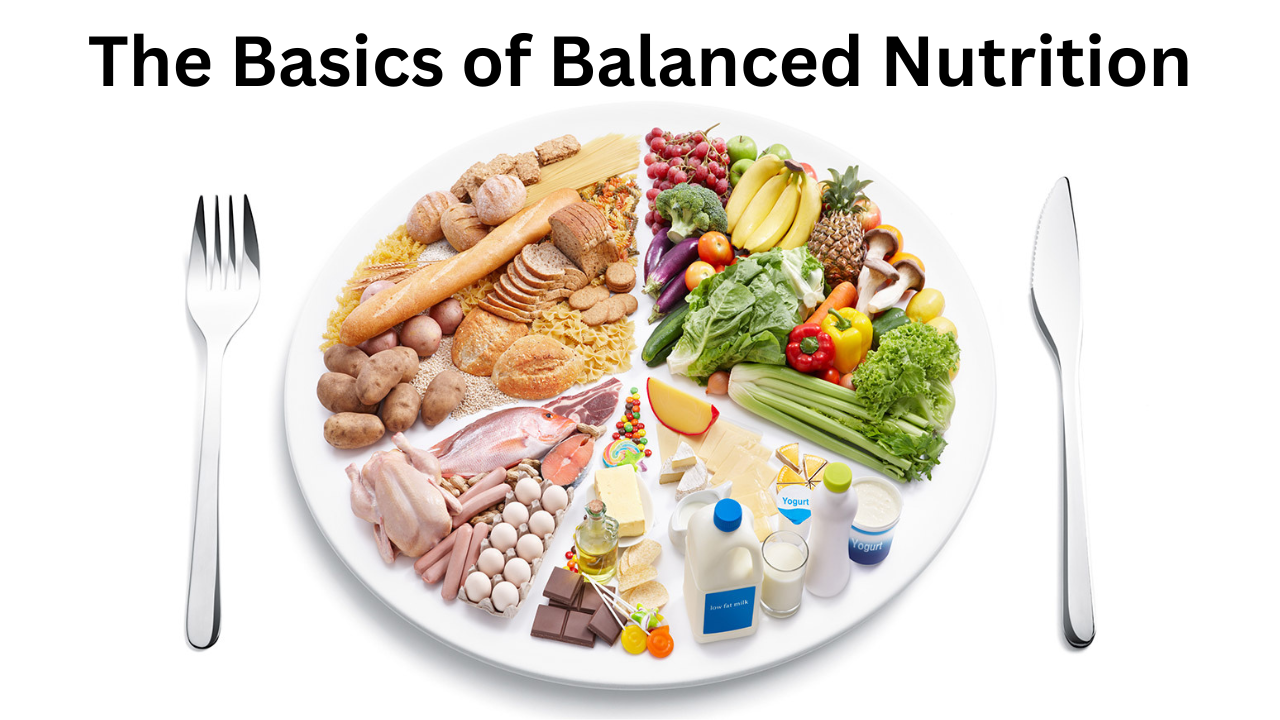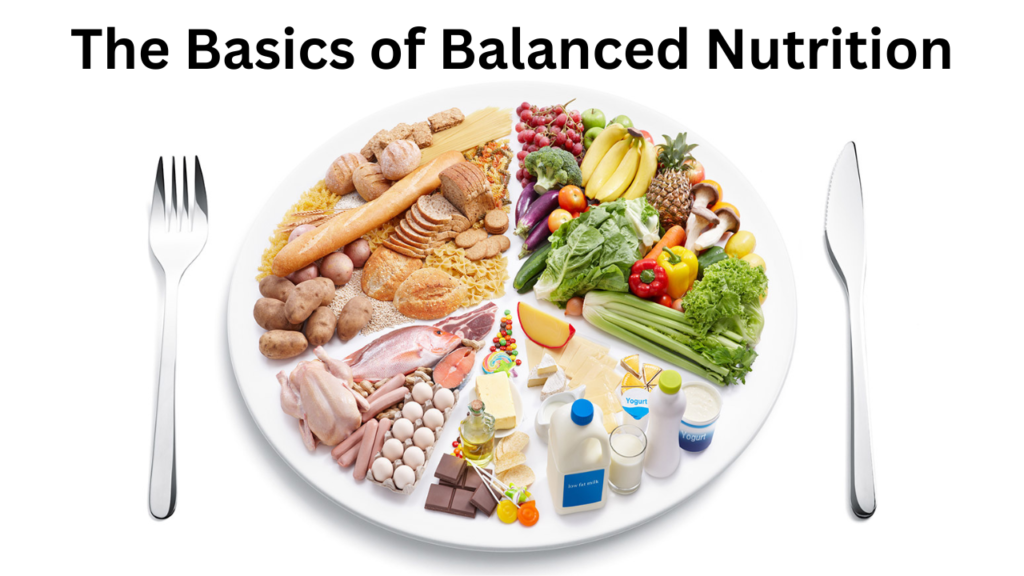

Table of Contents
Introduction
In the realm of health and wellness, balanced nutrition stands as a fundamental pillar. It’s more than just a dietary guideline; it’s a lifestyle that influences every aspect of our physical and mental well-being. Understanding what balanced nutrition entails and recognizing its profound importance can empower individuals to make informed choices that lead to a healthier, more fulfilling life.
Definition of Balanced Nutrition
Balanced nutrition refers to a diet that provides all the essential nutrients in the right proportions to maintain optimal health and support bodily functions. These nutrients include macronutrients—carbohydrates, proteins, and fats—and micronutrients—vitamins and minerals. Each nutrient plays a specific role in the body’s growth, repair, and maintenance.
Balanced Diet Typically Includes:
- Carbohydrates: The body’s main energy source, found in fruits, vegetables, whole grains, and legumes.
- Proteins: Crucial for building and repairing tissues, available in lean meats, fish, dairy, legumes, and nuts.
- Fats: Necessary for brain function, hormone production, and nutrient absorption, with healthy options found in avocados, nuts, seeds, and olive oil.
- Vitamins and Minerals: Essential for various biochemical processes, obtainable from a diverse intake of fruits, vegetables, lean proteins, and whole grains.
- Water: Vital for hydration, digestion, and overall bodily functions.
Balanced nutrition is about variety, moderation, and ensuring that the body receives adequate amounts of each nutrient to function optimally.
Importance of Balanced Nutrition for Overall Health
Balanced nutrition is crucial for maintaining overall health and well-being. Here are some key reasons why it is essential:
- Disease Prevention: A well-balanced diet can help prevent chronic diseases such as heart disease, diabetes, obesity, and certain cancers. For example, diets rich in fruits, vegetables, and whole grains are associated with a lower risk of cardiovascular disease.
- Energy and Vitality: Consuming the right balance of nutrients provides the body with the energy needed for daily activities and enhances physical performance and endurance.
- Mental Health: Nutrition significantly impacts brain function and mental well-being. Nutrients like omega-3 fatty acids, vitamins, and minerals are known to support cognitive function and reduce the risk of mental health disorders such as depression and anxiety.
- Growth and Development: Proper nutrition is essential for the growth and development of children and adolescents. It supports the formation of strong bones, healthy muscles, and robust immune systems.
- Weight Management: Balanced nutrition helps maintain a healthy weight by providing the necessary nutrients without excess calories. It also supports healthy metabolism and reduces the risk of weight-related issues.
- Improved Digestion: A diet rich in fiber from fruits, vegetables, and whole grains promotes healthy digestion and prevents issues like constipation and bloating.
- Enhanced Immunity: Essential nutrients like vitamins C and E, zinc, and selenium play a vital role in strengthening the immune system, helping the body fight off infections and illnesses.
Understanding Macronutrients
Macronutrients are the nutrients that our bodies need in larger quantities to provide energy and support bodily functions. The three main types of macronutrients are carbohydrates, proteins, and fats. Each plays a unique and essential role in maintaining health. In this section, we will focus on carbohydrates, exploring their definition, role in the body, sources, and the difference between simple and complex carbohydrates.
Carbohydrates
1. Definition and Role in the Body
Carbohydrates are organic compounds composed of carbon, hydrogen, and oxygen. They are one of the primary sources of energy for the body. Upon consumption, carbohydrates are broken down into glucose, which is then used by the body’s cells for energy. Glucose is especially important for the brain and muscles during physical activity.
Carbohydrates serve several critical functions:
- Energy Production: Carbohydrates are the body’s preferred energy source. Glucose derived from carbs is used for immediate energy needs, while excess glucose is stored in the liver and muscles as glycogen for later use.
- Sparing Protein: When the body has sufficient carbohydrates, it uses them for energy, sparing proteins to be used for building and repairing tissues.
- Fat Metabolism: Carbohydrates are necessary for the complete oxidation of fats. Without adequate carbs, the body cannot efficiently burn fat, leading to the production of ketones, which can cause ketosis if they accumulate.
2. Sources of Carbohydrates
Carbohydrates can be found in a wide variety of foods, including:
- Fruits: Apples, bananas, berries, and oranges are rich in natural sugars and fiber.
- Vegetables: Starchy vegetables like potatoes, corn, and peas, as well as non-starchy vegetables such as broccoli, spinach, and bell peppers.
- Grains: Whole grains like brown rice, oats, quinoa, and barley, as well as refined grains such as white bread and pasta.
- Legumes: Beans, lentils, and chickpeas are excellent sources of carbohydrates and protein.
- Dairy: Milk, yogurt, and cheese contain lactose, a natural carbohydrate.
3. Differentiating Between Simple and Complex Carbohydrates
Carbohydrates are categorized into two main types: simple and complex, based on their chemical structure and the speed at which they are digested and absorbed.
Simple Carbohydrates:
These are composed of one or two sugar units. They are quickly broken down by the body and provide a rapid source of energy. Simple carbohydrates are found in foods such as:
- Sugars: Table sugar (sucrose), fruit sugar (fructose), and milk sugar (lactose).
- Processed Foods: Candy, syrups, and soft drinks.
While they provide quick energy, simple carbohydrates can cause spikes in blood sugar levels, leading to energy crashes and increased hunger soon after consumption.
Complex Carbohydrates:
These consist of multiple sugar units bonded together. They are digested more slowly, providing a sustained source of energy. Complex carbohydrates are found in:
- Whole Grains: Brown rice, whole wheat bread, oatmeal, and quinoa.
- Vegetables: Sweet potatoes, squash, and legumes like lentils and beans.
Complex carbohydrates are generally more nutritious, providing fiber, vitamins, and minerals that are essential for overall health. They help maintain stable blood sugar levels and promote satiety, aiding in weight management.
Proteins
1. Definition and Importance for the Body
Proteins are complex molecules composed of amino acids, known as the building blocks of life. They play a crucial role in nearly every biological process, including muscle growth and repair, enzyme production, immune function, and hormone regulation. Proteins are essential for building and repairing tissues, making them vital for growth, development, and overall health.
2. Sources of Proteins
Proteins are found in both animal and plant-based foods, including:
- Animal Sources: Lean meats such as chicken, turkey, beef, and pork; fish and seafood like salmon, tuna, and shrimp; eggs, dairy products like milk, yogurt, and cheese.
- Plant Sources: Legumes such as beans, lentils, and chickpeas; soy products like tofu and tempeh; nuts and seeds such as almonds, walnuts, chia seeds, and hemp seeds; grains like quinoa and amaranth.
3. Recommended Daily Intake
The recommended daily intake of protein varies depending on factors such as age, sex, activity level, and overall health status. Generally, it is recommended that adults consume 0.8 grams of protein per kilogram of body weight per day. However, individual protein needs may vary, with athletes, pregnant or breastfeeding women, and older adults often requiring higher protein intake to support muscle maintenance, growth, and repair.
Fats
1. Definition and Role in the Body
Fats are a class of macronutrients that are essential for various bodily functions. They are an important source of energy, providing more than twice the number of calories per gram compared to carbohydrates and proteins. Fats also play crucial roles in cell membrane structure, hormone production, vitamin absorption, and insulation.
2. Differentiating Between Saturated and Unsaturated Fats
- Saturated Fats: Saturated fats are primarily found in animal products such as meat, dairy, and eggs, as well as in some plant-based oils like coconut oil and palm oil. They are typically solid at room temperature and have been associated with an increased risk of heart disease when consumed in excess.
- Unsaturated Fats: Unsaturated fats, including monounsaturated and polyunsaturated fats, are found in foods such as avocados, nuts, seeds, and vegetable oils like olive oil, canola oil, and sunflower oil. They are typically liquid at room temperature and are considered heart-healthy fats, as they can help lower LDL (bad) cholesterol levels and reduce the risk of heart disease when consumed in moderation.
3. Sources of Healthy Fats
Including healthy fats in your diet is essential for overall health. Sources of healthy fats include:
- Avocados: Rich in monounsaturated fats, avocados are a versatile and nutritious addition to any meal.
- Nuts and Seeds: Almonds, walnuts, chia seeds, flaxseeds, and hemp seeds are excellent sources of healthy fats, fiber, and various vitamins and minerals.
- Oily Fish: Salmon, mackerel, trout, and sardines are rich in omega-3 fatty acids, which have been linked to numerous health benefits, including reduced inflammation and improved heart health.
- Olive Oil: Extra virgin olive oil is a staple of the Mediterranean diet and is prized for its high content of monounsaturated fats and antioxidants.
Incorporating a variety of healthy fats into your diet can help support overall health and well-being while reducing the risk of chronic diseases like heart disease and diabetes. Remember to enjoy fats in moderation as part of a balanced diet.
Exploring Micronutrients
Micronutrients are essential nutrients required by the body in smaller quantities compared to macronutrients, but they play critical roles in various bodily functions. In this section, we’ll delve into vitamins and minerals, understanding their importance, different types, roles, and food sources.
Vitamins
1. Importance of Vitamins for Various Bodily Functions
Vitamins are organic compounds that the body needs in small amounts to function properly. They play crucial roles in metabolism, immune function, cell growth and repair, and numerous other physiological processes. Vitamins act as cofactors for enzymes, facilitating biochemical reactions that are essential for energy production, DNA synthesis, and overall health. Deficiencies in vitamins can lead to a range of health problems, including fatigue, weakened immune system, and impaired cognitive function.
2. Different Types of Vitamins and Their Food Sources
Vitamins are classified into two main categories: fat-soluble vitamins (A, D, E, and K) and water-soluble vitamins (B-complex vitamins and vitamin C). Here are some examples of each type and their food sources:
Fat-Soluble Vitamins:
- Vitamin A: Found in liver, fish oil, dairy products, and orange and yellow fruits and vegetables like carrots and sweet potatoes.
- Vitamin D: Obtained from sunlight exposure and found in fatty fish, fortified dairy products, and egg yolks.
- Vitamin E: Found in nuts, seeds, vegetable oils, and leafy green vegetables.
- Vitamin K: Found in green leafy vegetables like kale, spinach, and broccoli, as well as in liver and egg yolks.
Water-Soluble Vitamins:
- Vitamin B-complex: Includes B1 (thiamine), B2 (riboflavin), B3 (niacin), B5 (pantothenic acid), B6 (pyridoxine), B7 (biotin), B9 (folate), and B12 (cobalamin). Food sources include whole grains, meat, poultry, fish, eggs, dairy products, legumes, and leafy green vegetables.
- Vitamin C: Found in citrus fruits, berries, kiwi, tomatoes, peppers, and leafy green vegetables.
Consuming a varied and balanced diet rich in fruits, vegetables, whole grains, lean proteins, and dairy products can help ensure an adequate intake of vitamins.
Minerals
1. Role of Minerals in Maintaining Health
Minerals are inorganic elements that are essential for various physiological functions in the body. They play vital roles in bone health, muscle function, fluid balance, nerve transmission, and enzyme activity. Minerals are critical for maintaining the structural integrity of tissues, regulating fluid balance, and supporting numerous biochemical processes. Deficiencies or excesses of minerals can lead to a range of health problems, including osteoporosis, anemia, and electrolyte imbalances.
2. Common Minerals and Their Sources
Some common minerals and their food sources include:
- Calcium: Essential for bone and teeth health, found in dairy products, leafy green vegetables, tofu, and fortified foods.
- Iron: Necessary for oxygen transport and energy production, found in red meat, poultry, fish, beans, lentils, and fortified cereals.
- Magnesium: Involved in muscle and nerve function, energy metabolism, and bone health, found in nuts, seeds, whole grains, leafy green vegetables, and legumes.
- Potassium: Important for fluid balance, muscle function, and nerve transmission, found in bananas, oranges, potatoes, tomatoes, and leafy green vegetables.
- Sodium: Critical for fluid balance and nerve function, found in table salt, processed foods, and naturally in small amounts in fruits and vegetables.
Including a variety of nutrient-rich foods in your diet can help ensure an adequate intake of minerals necessary for optimal health and well-being.
Hydration: The Forgotten Nutrient
In the bustling world of nutrition, amidst discussions of macronutrients and micronutrients, one essential nutrient often takes a backseat: water. Yet, hydration is crucial for maintaining optimal health and well-being. Let’s delve into the importance of water for the body, recommended daily intake, and tips for staying hydrated.
Importance of Water for the Body
Water is the elixir of life, essential for nearly every bodily function. It serves as a solvent for biochemical reactions, aids in digestion and nutrient absorption, regulates body temperature, cushions joints and organs, and facilitates the elimination of waste products through urine and sweat. Every cell, tissue, and organ in the body relies on adequate hydration to function optimally. Even slight dehydration can lead to decreased cognitive function, fatigue, headaches, and impaired physical performance.
Recommended Daily Water Intake
Determining the exact amount of water needed varies based on factors such as age, sex, weight, climate, activity level, and overall health status. However, a general guideline is to aim for approximately 8 glasses of water per day, which is roughly equivalent to about 2 liters or half a gallon. This recommendation can vary, with some individuals requiring more water, especially those who are physically active, live in hot climates, or are pregnant or breastfeeding.
Tips for Staying Hydrated
Staying hydrated doesn’t have to be a daunting task. Here are some practical tips to help ensure you meet your daily fluid needs:
- Keep a Water Bottle Handy: Carry a reusable water bottle with you throughout the day to remind yourself to drink regularly. Opt for a bottle with measurements to track your intake.
- Drink Water Before Meals: Start each meal with a glass of water. Not only does this help with hydration, but it can also promote feelings of fullness and prevent overeating.
- Set Reminders: Use smartphone apps or set alarms to remind yourself to drink water at regular intervals, especially if you tend to forget.
- Infuse Your Water: Add natural flavors to your water by infusing it with slices of fruits like lemon, lime, cucumber, or berries. This can make drinking water more enjoyable and flavorful.
- Eat Water-Rich Foods: Incorporate water-rich foods into your diet, such as fruits (watermelon, oranges, grapes), vegetables (cucumbers, tomatoes, celery), and broth-based soups.
- Monitor Urine Color: Check the color of your urine as a simple indicator of hydration status. Ideally, urine should be pale yellow; darker urine may indicate dehydration.
- Drink Before You’re Thirsty: Thirst is a late indicator of dehydration. Aim to drink water throughout the day, even if you don’t feel thirsty.
- Limit Caffeine and Alcohol: Beverages containing caffeine and alcohol can have a diuretic effect, increasing fluid loss. Limit intake and balance with water consumption.
By incorporating these simple strategies into your daily routine, you can ensure proper hydration and reap the countless benefits that water provides for your body and mind.
Creating a Balanced Plate
In the quest for optimal nutrition, creating a balanced plate is key to ensuring that your body receives the necessary nutrients for health and vitality. Let’s explore the concepts of portion control and building a balanced meal, incorporating both macronutrients and micronutrients.
The Concept of Portion Control
Portion control refers to the practice of managing the amount of food you consume in a single sitting to ensure that you’re not overeating. It’s about being mindful of serving sizes and listening to your body’s hunger and fullness cues. Portion control is important for weight management, as consuming excessive portions can lead to weight gain over time. It also allows you to enjoy a variety of foods without feeling deprived or guilty.
Practical tips for portion control include:
- Use Visual Cues: Familiarize yourself with common portion sizes using visual aids such as measuring cups, spoons, and your hand as a guide.
- Read Food Labels: Pay attention to serving sizes listed on food labels and stick to recommended portions.
- Be Mindful of Your Hunger: Eat when you’re hungry and stop when you’re satisfied, rather than eating until you’re uncomfortably full.
- Slow Down: Eat slowly and savor each bite, giving your body time to register feelings of fullness.
- Practice Balanced Eating: Include a variety of foods in your meals to ensure you’re getting a mix of nutrients without overdoing it on any one food group.
Building a Balanced Meal
Building a balanced meal involves incorporating a variety of foods that provide essential macronutrients (carbohydrates, proteins, and fats) and micronutrients (vitamins and minerals) to support overall health and well-being.
1. Incorporating Macronutrients and Micronutrients
- Carbohydrates: Choose whole grains such as brown rice, quinoa, or whole wheat pasta as the base of your meal. These provide fiber, vitamins, and minerals.
- Proteins: Include lean protein sources like chicken, fish, tofu, beans, or lentils to support muscle growth and repair.
- Fats: Incorporate healthy fats from sources like avocado, nuts, seeds, or olive oil for satiety and to support brain and heart health.
- Micronutrients: Fill your plate with a variety of colorful fruits and vegetables to ensure you’re getting a range of vitamins, minerals, and antioxidants. Aim for a rainbow of colors to maximize nutrient diversity.
A balanced meal might look something like this:
- Grilled Chicken Breast: A palm-sized portion provides protein for muscle repair.
- Quinoa Salad: A side dish of quinoa mixed with leafy greens, cherry tomatoes, cucumber, and bell peppers provides fiber, vitamins, and minerals.
- Steamed Broccoli: A serving of steamed broccoli on the side adds additional fiber, vitamins (such as vitamin C), and minerals (such as potassium and calcium).
- Sliced Avocado: A quarter of an avocado adds healthy fats to the meal.
By incorporating a variety of nutrient-dense foods in appropriate portion sizes, you can create balanced meals that support your overall health and well-being. Remember to listen to your body’s hunger and fullness cues, and enjoy your meals mindfully.
2. Examples of Balanced Meals
Creating balanced meals doesn’t have to be complicated. By incorporating a variety of nutrient-rich foods from different food groups, you can easily build meals that provide the essential nutrients your body needs for optimal health. Here are some examples of balanced meals to inspire your culinary creations:
Grilled Salmon with Roasted Vegetables and Quinoa
- Grilled Salmon: A serving of grilled salmon provides lean protein, omega-3 fatty acids, and vitamin D.
- Roasted Vegetables: A mix of colorful vegetables such as bell peppers, zucchini, carrots, and broccoli, roasted with olive oil and herbs, provides fiber, vitamins, and minerals.
- Quinoa: Cooked quinoa serves as a nutritious base, offering complex carbohydrates, protein, and essential nutrients like magnesium and iron.
Veggie Stir-Fry with Tofu and Brown Rice
- Tofu Stir-Fry: Cubes of tofu stir-fried with an assortment of colorful vegetables like bell peppers, snap peas, carrots, and mushrooms provide plant-based protein, fiber, and an array of vitamins and minerals.
- Brown Rice: Steamed brown rice complements the stir-fry, offering complex carbohydrates, fiber, and additional nutrients such as manganese and selenium.
Chicken and Vegetable Skewers with Quinoa Salad
- Chicken Skewers: Skewers of marinated chicken breast, cherry tomatoes, zucchini, and red onion, grilled to perfection, provide lean protein and a variety of vitamins and minerals.
- Quinoa Salad: A refreshing salad made with cooked quinoa, diced cucumber, cherry tomatoes, red onion, fresh herbs, and a squeeze of lemon juice offers a satisfying side dish packed with fiber, protein, and essential nutrients.
Lentil and Spinach Curry with Brown Rice
- Lentil Curry: A hearty curry made with lentils, spinach, tomatoes, onions, garlic, and a blend of spices like turmeric, cumin, and coriander, offers plant-based protein, fiber, and a plethora of vitamins and minerals.
- Brown Rice: Steamed brown rice serves as a nutritious accompaniment, providing complex carbohydrates, fiber, and essential nutrients.
Greek Salad with Grilled Chicken and Whole Wheat Pita
- Greek Salad: A refreshing salad made with mixed greens, cucumber, tomato, red onion, Kalamata olives, and feta cheese, drizzled with olive oil and lemon juice, offers a burst of flavor along with vitamins, minerals, and healthy fats.
- Grilled Chicken: Slices of grilled chicken breast on top of the salad provide lean protein for muscle repair and satiety.
- Whole Wheat Pita: A whole wheat pita bread on the side adds complex carbohydrates and fiber to the meal.
Oatmeal with Greek Yogurt and Berries
- Oatmeal: A bowl of cooked oats topped with a dollop of Greek yogurt provides fiber, protein, and complex carbohydrates to fuel your morning.
- Berries: Fresh berries such as strawberries, blueberries, or raspberries add natural sweetness along with antioxidants, vitamins, and minerals.
- Nuts and Seeds: Sprinkle some nuts and seeds like almonds, walnuts, or chia seeds for added texture, healthy fats, and micronutrients.
These examples demonstrate how simple it can be to create balanced meals that nourish your body and delight your taste buds. Feel free to mix and match ingredients based on your preferences and dietary needs, and enjoy the journey of creating delicious and nutritious meals.
Practical Tips for Achieving Balanced Nutrition
Maintaining balanced nutrition is essential for overall health and well-being. Here are some practical tips to help you achieve a balanced diet in your daily life:
Reading Food Labels
- Check Serving Sizes: Pay attention to the serving size listed on the nutrition label. It’s easy to underestimate portion sizes, so be sure to adjust your intake accordingly.
- Understand Nutrient Content: Look for information on macronutrients (carbohydrates, proteins, fats) and micronutrients (vitamins and minerals). Aim for foods that are low in saturated fats, added sugars, and sodium, while being high in fiber, vitamins, and minerals.
- Scan the Ingredient List: Ingredients are listed in descending order by weight, so the first few ingredients are the most prevalent. Choose products with whole food ingredients and avoid those with long lists of additives and preservatives.
Meal Planning and Preparation
- Plan Ahead: Take some time each week to plan your meals and snacks. This can help you make healthier choices and avoid last-minute decisions based on convenience.
- Create a Grocery List: Make a list of the ingredients you need before heading to the grocery store. Stick to your list to avoid impulse purchases of unhealthy foods.
- Batch Cooking: Prepare large batches of meals and portion them out into containers for easy grab-and-go options throughout the week. This can save you time and money while ensuring you have nutritious meals readily available.
Making Healthy Choices When Eating Out
- Research Menus in Advance: Many restaurants provide nutrition information online, so take some time to review the menu and choose healthier options before arriving.
- Ask for Modifications: Don’t be afraid to ask for substitutions or modifications to make dishes healthier. For example, request grilled instead of fried, dressing on the side, or steamed vegetables instead of fries.
- Practice Portion Control: Restaurant portions are often larger than what you need, so consider sharing a meal with a friend or taking half of it home for later.
- Focus on Balance: Aim to include a variety of food groups in your meal, such as lean protein, whole grains, fruits, and vegetables. This ensures you’re getting a mix of nutrients while enjoying your dining experience.
By incorporating these practical tips into your daily routine, you can make balanced nutrition more attainable and sustainable. Remember that small changes add up over time, so be patient with yourself and celebrate your progress toward a healthier lifestyle.
Addressing Common Misconceptions
In the ever-evolving landscape of nutrition, misinformation and myths often abound. Let’s address some common misconceptions about certain foods or nutrients, as well as clarify misunderstandings surrounding fad diets.
Debunking Myths About Certain Foods or Nutrients
Myth: Eggs are bad for your heart because they are high in cholesterol.
- Fact: While eggs do contain cholesterol, dietary cholesterol has less impact on blood cholesterol levels than saturated and trans fats. Eggs are a nutritious source of protein, vitamins, and minerals and can be part of a healthy diet when consumed in moderation.
Myth: Carbohydrates are fattening and should be avoided for weight loss.
- Fact: Carbohydrates are an essential source of energy for the body, and not all carbs are created equal. Whole grains, fruits, vegetables, and legumes provide valuable nutrients and fiber, while refined carbs like white bread and sugary snacks should be limited.
Myth: Eating late at night leads to weight gain.
- Fact: The timing of meals and snacks does not directly affect weight gain. Weight management is determined by overall calorie intake and expenditure throughout the day. However, late-night eating may lead to poor food choices or overeating due to fatigue or boredom.
Clarifying Misconceptions About Fad Diets
Misconception: Fad diets provide long-term, sustainable weight loss.
- Clarification: Fad diets often promise rapid weight loss through drastic restrictions or elimination of certain food groups. While they may result in short-term weight loss, they are not sustainable or healthy in the long run. They can lead to nutrient deficiencies, muscle loss, and rebound weight gain once normal eating patterns resume.
Misconception: Low-fat or fat-free foods are always healthier options.
- Clarification: Many low-fat or fat-free products compensate for reduced fat content by increasing sugar or artificial additives to improve taste and texture. In some cases, these products may be less nutritious and higher in calories than their full-fat counterparts. Choosing whole, minimally processed foods and incorporating healthy fats in moderation is a better approach to nutrition.
Misconception: Detox diets are effective for cleansing the body of toxins.
- Clarification: The body has its own efficient detoxification system involving the liver, kidneys, and other organs. Most detox diets lack scientific evidence and may be restrictive or extreme, leading to potential health risks and nutrient imbalances. Adopting a balanced diet rich in fruits, vegetables, whole grains, and lean proteins supports the body’s natural detoxification processes without the need for drastic measures.
By dispelling myths about certain foods or nutrients and clarifying misconceptions about fad diets, individuals can make more informed choices about their dietary habits and embrace a balanced approach to nutrition that promotes long-term health and well-being.
Conclusion
As we conclude our exploration of nutrition, let’s recap the importance of balanced nutrition and offer encouragement for readers to prioritize their health through mindful eating choices.
Recap of the Importance of Balanced Nutrition
Balanced nutrition is the foundation of a healthy lifestyle, providing the essential nutrients our bodies need to thrive. From macronutrients like carbohydrates, proteins, and fats to micronutrients like vitamins and minerals, each component plays a vital role in supporting bodily functions, promoting optimal health, and preventing disease. By embracing the principles of balanced nutrition, individuals can fuel their bodies effectively, maintain a healthy weight, and enhance overall well-being.
Encouragement for Readers to Prioritize Their Health Through Mindful Eating Choices
As you journey forward, I encourage you to prioritize your health by making mindful eating choices. Listen to your body’s hunger and fullness cues, savor the flavors and textures of nutritious foods, and cultivate a balanced approach to eating that nourishes both body and soul. Remember that small changes add up over time, so focus on progress, not perfection. Whether it’s choosing whole foods over processed ones, incorporating more fruits and vegetables into your meals, or practicing portion control, every step towards healthier eating is a step towards a brighter, healthier future.
In your pursuit of balanced nutrition, may you find joy in discovering new flavors, satisfaction in nourishing your body with wholesome foods, and empowerment in taking control of your health. Here’s to embracing a life of vitality, wellness, and abundance through the power of balanced nutrition. Cheers to your health and happiness!






